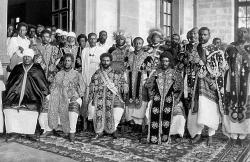
Published date
3 April 1930
Born in 1891 (some sources say 1894), Tafari Makonnen, or Haile Selassie, as he was later known, was born the son of Ras Makonnen Wolde Michael, the Governor of the region of Harrar. He is credited for modernising Ethiopia (previously known as Abyssinia) by transforming its government and institutions from a feudal system into a constitutional monarchy, as well as opposing and resisting Italian attempts to colonise Ethiopia. Despite great opposition from conservative elements among Ethiopia's nobility, Selassie succeeded the Emperor Menelik II as ruler of Ethiopia on 3 April 1930. He immediately set about modernising the Ethiopian systems of governance, education, and industry. However, the tensions that he encountered while ascending the throne, would haunt his reign for the rest of his life. This would eventually play a substantial role in his overthrow by the Marxist dictator Mengistu Haile Mariam, as his rivals would eventually side against him, as they did when Ethiopia was occupied by Italy. Despite transgressions some have claimed Selassie committed during his reign, the position he occupied, as an African leader of an empire that claimed a pedigree older than most European empires, gave hope to many African countries seeking to cast off the yoke of Colonialism.
References
Britannica, Haile Selassie I, from Encyclopaedia Britannica, [online], Available at britannica.com [Accessed: 29 March 2010]|IE, Imperial Ethiopia Homepage, from Angelfire, [online], Available at angelfire.com [Accessed: 29 March 2010]| Wallis, F. (2000). Nuusdagboek: feite en fratse oor 1000 jaar, Kaapstad: Human & Rousseau.)